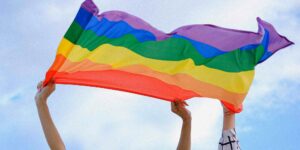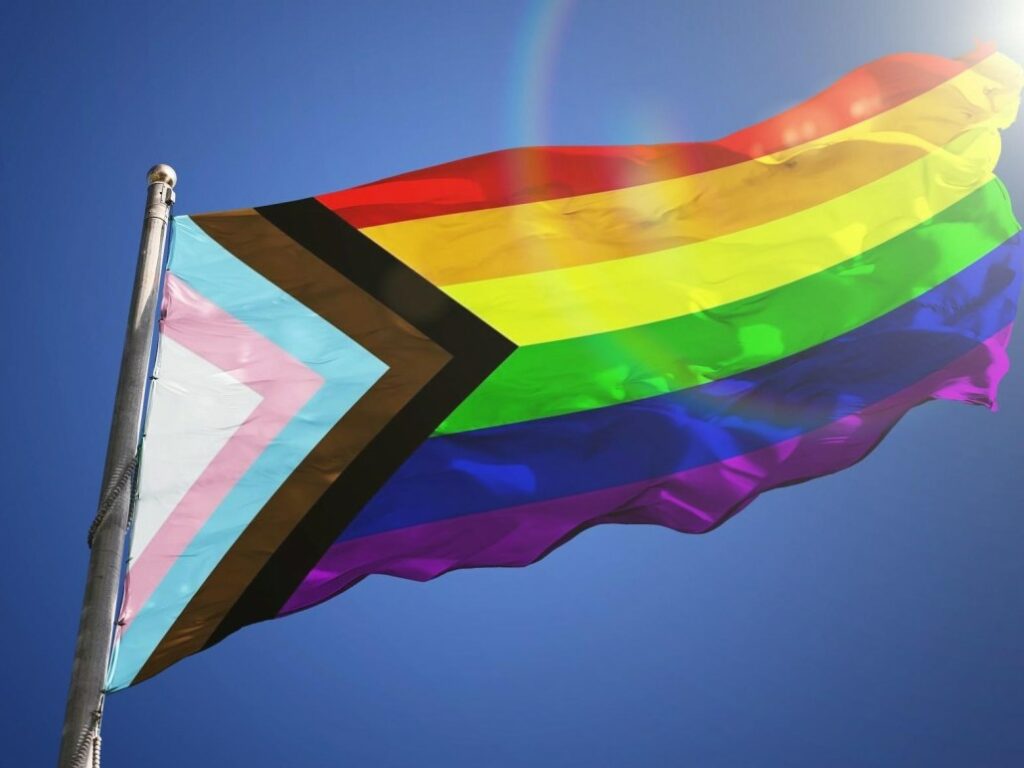In the vibrant spectrum of humanity, the Pride Flag stands as a powerful symbol of diversity, acceptance, and solidarity. Emerging from the tumultuous tides of history, it has woven itself into the very fabric of modern society, inspiring millions with its dazzling array of colors. This symbol, with each color depicting a distinct aspect of LGBTQ+ life and a rallying cry for equality. In this blog post, we dive deep into the rich tapestry of the Pride Flag, exploring its history, its meaning, and the influence it has on today’s society.
Contents
What Is The History Of The Pride Flag?
 The original Pride Flag, also known as the Rainbow Flag, was created in 1978 by Gilbert Baker, a San Francisco-based artist and gay rights activist. The design was commissioned by Harvey Milk, one of the first openly gay elected officials in U.S. history, who saw the need for a powerful visual symbol that the LGBTQ+ community could rally around. Initially, the flag included eight colors—each representing a different aspect of life, like sexuality, life, healing, spirit, etc.
The original Pride Flag, also known as the Rainbow Flag, was created in 1978 by Gilbert Baker, a San Francisco-based artist and gay rights activist. The design was commissioned by Harvey Milk, one of the first openly gay elected officials in U.S. history, who saw the need for a powerful visual symbol that the LGBTQ+ community could rally around. Initially, the flag included eight colors—each representing a different aspect of life, like sexuality, life, healing, spirit, etc.
However, due to production constraints, the flag was later simplified. In 1979, hot pink was dropped because the dye was too expensive and hard to source, and the flag was reduced to seven colors. Shortly thereafter, in order to achieve an even number for the purpose of splitting for display on San Francisco’s Market Street, the turquoise stripe was also removed. So, finalizing the widely recognized six-color version of the flag. This version of the Flag has been used since then to represent the LGBTQ+ community’s diversity and unity.
What Are The Pride Colors?
The current widely recognized version of the Pride Flag, often known as the Rainbow Flag, includes six colors. Each color has a specific symbolic meaning:
- Red
- Orange
- Yellow
- Green
- Blue (replaced the original Turquoise and Indigo)
- Violet
The original eight-color flag included two additional colors:
- Hot Pink (This color was removed due to the difficulty of sourcing the fabric.)
- Turquoise (This color was dropped to maintain an even number of stripes for display.)
In 2018, a revised version of the flag was introduced to bring attention to racial inclusivity within the LGBTQ+ community. This flag is known as the Progress Pride Flag. It added a five-colored chevron to the classic rainbow flag with black and brown stripes to represent people of color. And the colors of the Transgender Flag (light blue, light pink, and white).
What Does The Pride Flag Symbolize?
 The Pride Flag is a powerful symbol of pride, diversity, unity, and acceptance for the LGBTQ+ (Lesbian, Gay, Bisexual, Transgender, Queer/Questioning, and others) community. Each color on the flag represents a different aspect of life and human nature:
The Pride Flag is a powerful symbol of pride, diversity, unity, and acceptance for the LGBTQ+ (Lesbian, Gay, Bisexual, Transgender, Queer/Questioning, and others) community. Each color on the flag represents a different aspect of life and human nature:
- Red symbolizes life.
- Orange represents healing.
- Yellow stands for sunlight.
- Green signifies nature.
- Blue symbolizes serenity or harmony.
- Violet represents spirit.
These colors together reflect the diversity within the LGBTQ+ community. And the spectrum of experiences and identities it includes.
The flag’s rainbow design is no coincidence either. Rainbows typically signify hope, dreams, and possibility, and their use in the Flag carries these meanings over. The flag is frequently displayed during Pride Month and at other LGBTQ+ events. This signifies a safe and accepting space for all identities.
The updated Progress Pride Flag further includes a five-colored chevron with black and brown stripes. And this acknowledges the often overlooked and unique experiences of LGBTQ+ people of color. The light blue, light pink, and white colors are taken from the Transgender Pride Flag. And emphasizing the inclusion of transgender individuals in the broader LGBTQ+ community.
In its totality, the Pride Flag is not just a colorful banner. But a strong political symbol, a declaration of visibility, and a sign of the ongoing fight for LGBTQ+ rights and equality.
How the Pride Flag Shaped and Continues to Influence LGBTQ+ Activism?
The Pride Flag has been a prominent emblem in LGBTQ+ activism since its inception in 1978. As a highly visible and instantly recognizable symbol, the flag played a vital role in unifying various LGBTQ+ groups and individuals under a common banner. Its bright, rainbow colors served to contrast with the often dark and negative depictions of LGBTQ+ individuals in media and society at the time. And signaling joy, diversity, and community instead.
In the early years of the gay rights movement, the flag served as a sign of defiance and resilience in the face of discrimination and violence. It was used in protests and marches, helping to galvanize the community and draw public attention to LGBTQ+ issues. Over time, the Pride Flag became a symbol of protest. Also celebration of LGBTQ+ identities and achievements.
Today, this continues to be a powerful tool in LGBTQ+ activism. Its presence at Pride parades, protests, and other events serves as a reminder of the progress made and the struggles still ongoing for equality. It’s used in campaigns for legal rights, societal acceptance, and discrimination. Eventually, serving as a unifying symbol that transcends national and cultural boundaries.
Moreover, the flag’s evolution – like the addition of black, brown, and transgender colors in the Progress Pride Flag – demonstrates the adaptability of the LGBTQ+ movement. And its commitment to inclusivity and intersectionality. It signifies an ongoing dialogue within the community about what it means to be inclusive and how to best represent that visually.
Therefore, this is more than a mere symbol. Rather, it’s an embodiment of the past, present, and future of LGBTQ+ activism, continuously shaping and being shaped by the community it represents.
Common Misconceptions And Myths About The Pride Flag
 Despite its worldwide recognition, the Pride Flag, or Rainbow Flag, has been subjected to several misconceptions and myths that can distort its true meaning and history. Here are a few common ones:
Despite its worldwide recognition, the Pride Flag, or Rainbow Flag, has been subjected to several misconceptions and myths that can distort its true meaning and history. Here are a few common ones:
- The Pride Flag Represents All Marginalized Groups
While the Pride Flag is a symbol of diversity and inclusion, it specifically represents the LGBTQ+ community. Other marginalized groups may have their own flags and symbols.
- All Pride Flags Are the Same
There are many variations of the Pride Flag that represent different identities within the LGBTQ+ community. For example, the Bisexual Pride Flag, the Transgender Pride Flag, and the Lesbian Pride Flag all have different designs and colors.
- This Flag Is Only Relevant During Pride Month
While the flag is often more visible during June (Pride Month), it is a year-round symbol of LGBTQ+ pride, resistance, and community.
- This Flag and the Peace Flag Are the Same
Despite both featuring a rainbow, this and the Peace Flag are distinct. The Peace Flag, with its seven colors and horizontal stripes, was first used in Italy in 1961 as a sign of peace and cooperation.
- The Pride Flag Is Against Religion
The Pride Flag represents acceptance and inclusivity and doesn’t stand against any religion. There are many religious individuals and groups within the LGBTQ+ community, and many religious communities support LGBTQ+ rights.
- The Colors Don’t Have Specific Meanings
Each color on the Pride Flag has a specific meaning, representing life (red), healing (orange), sunlight (yellow), nature (green), harmony/serenity (blue), and spirit (purple/violet).
By debunking these misconceptions and myths, we can better appreciate the Pride Flag’s significance and its role in promoting LGBTQ+ visibility, inclusivity, and equality.
Conclusion
From its historical roots to its symbolic colors, the flag has had an indelible impact on the LGBTQ+ activism landscape. It stands as a testament to the community’s progress and as a beacon illuminating the path to a more inclusive future. The various iterations and adaptations of the flag underscore the evolving dialogue within the community. This ensures that no identity is left in the shadows.
This replete with myths and misconceptions, is far more than just a colorful banner displayed during Pride Month. It’s a year-round reminder of the rich diversity within the LGBTQ+ community and the enduring spirit that propels it toward greater acceptance and equality.
Life may sometimes be challenging for people from the LGBTQ community, but Online LGBTQ Counseling can help. Get experienced LGBTQ therapists at PrideMantra: Book a trial LGBTQ therapy session


